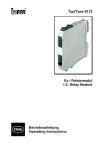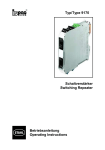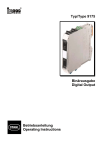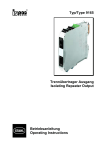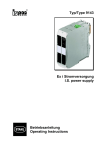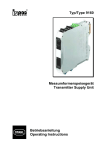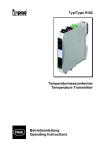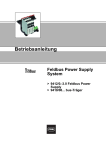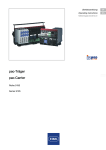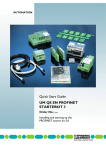Download Typ/Type 9193 Einspeisemodul Supply Module
Transcript
Typ/Type 9193 Einspeisemodul Supply Module Betriebsanleitung Operating Instructions Inhaltsverzeichnis 1 2 3 4 5 5.1 5.2 5.3 6 6.1 6.2 6.3 7 7.1 7.2 8 9 10 Sicherheitshinweise ....................................................................................................3 Normenkonformität .....................................................................................................3 Funktion ......................................................................................................................4 Kennzeichnung und technische Daten .......................................................................4 Projektierung...............................................................................................................5 Maximal zulässige Umgebungstemperaturen .........................................................5 Verlustleistung.........................................................................................................5 Projektierung der Verlustleistung in Schaltschränken .............................................6 Anordnung und Montage ............................................................................................7 Maßzeichnung.........................................................................................................7 Installation ...............................................................................................................7 Montage und Demontage........................................................................................7 Inbetriebnahme ...........................................................................................................8 Anschlüsse ..............................................................................................................8 Einstellungen (nur 9193/20-11-11)..........................................................................8 Betrieb- und Betriebszustände....................................................................................9 Reparatur und Instandhaltung ....................................................................................9 Zubehör und Ersatzteile..............................................................................................9 Contents 1 2 3 4 5 5.1 5.2 5.3 6 6.1 6.2 6.3 7 7.1 7.2 8 9 10 Safety instructions.....................................................................................................10 Conformity to standards............................................................................................10 Function ....................................................................................................................11 Marking and technical data .......................................................................................11 Engineering...............................................................................................................12 Max. ambient temperatures...................................................................................12 Power dissipation ..................................................................................................12 Engineering of the power dissipation in cabinets ..................................................13 Arrangement and fitting.............................................................................................14 Dimensions............................................................................................................14 Installation .............................................................................................................14 Installation advices ................................................................................................14 Commissioning .........................................................................................................15 Connection ............................................................................................................15 Settings (only 9193/20-11-11) ...............................................................................15 Operation and operational states..............................................................................16 Maintenance and repair ............................................................................................16 Accessories and spare parts.....................................................................................16 EG-Konformitätserklärung / EC-Declaration of Conformity .................................................17 Baumusterprüfbescheinigung ..............................................................................................18 Type Examination Certificate...............................................................................................19 2 deutsch 1 Betriebsanleitung Sicherheitshinweise In diesem Kapitel sind die wichtigsten Sicherheitsmaßnahmen zusammengefasst. Es ergänzt die entsprechenden Vorschriften, zu deren Studium das verantwortliche Personal verpflichtet ist. Bei Arbeiten in explosionsgefährdeten Bereichen hängt die Sicherheit von Personen und Anlagen von der Einhaltung aller relevanten Sicherheitsvorschriften ab. Das Montage- und Wartungspersonal trägt deshalb eine besondere Verantwortung. Die Voraussetzung dafür ist die genaue Kenntnis der geltenden Vorschriften und Bestimmungen. Bei Errichtung und Betrieb ist Folgendes zu beachten: • Es gelten die nationalen Montage- und Errichtungsvorschriften (z.B. EN 60079-14). • Das Einspeisemodul ist in Zone 2, Zone 22 oder außerhalb explosionsgefährdeter Bereiche zu installieren • Bei Einsatz in Zone 2 ist das Einspeisemodul in ein Gehäuse einzubauen, das den Anforderungen der EN 50 021 genügt. • Bei Einsatz in Zone 22 ist das Einspeisemodul in ein Gehäuse einzubauen, das den Anforderungen der EN 50 281 genügt • Das Auswechseln der frontseitigen Sicherungen PWR1 und PWR2 (wenn vorhanden) ist in der Zone 2 nur im spannungslosen Zustand zulässig. • Die nationalen Sicherheits- und Unfallverhütungsvorschriften • Die allgemein anerkannten Regeln der Technik • Die Sicherheitshinweise dieser Betriebsanleitung • Beschädigungen können den Explosionsschutz aufheben. Verwenden Sie das Gerät bestimmungsgemäß, nur für den zugelassenen Einsatzzweck (siehe „Funktion“). Fehlerhafter oder unzulässiger Einsatz sowie das Nichtbeachten der Hinweise dieser Betriebsanleitung schließen eine Gewährleistung unsererseits aus. Umbauten und Veränderungen am Gerät sind nicht gestattet. Das Gerät darf nur in unbeschädigtem, trockenem und sauberem Zustand eingebaut und betrieben werden 2 Normenkonformität Das Einspeisemodul Typ 9193 entspricht den folgenden Normen bzw. der folgenden Richtlinie: • Richtlinie 94/9/EG • EN 50 021 • EN 61 326 • VDE 0110 Einspeisemodul Typ 9193 3 Betriebsanleitung 3 deutsch Funktion Das Einspeisemodul dient zur Hilfsenergieeinspeisung von 24 VDC / max. 4 A in den pacBus. Bei der Varianten 9193/20 kann dies auch redundant, durch Dioden entkoppelt, geschehen. Zusätzlich wird bei dieser Variante ein Hilfsenergie- oder Sicherungsausfall über einen Relaiskontakt gemeldet. Ein Leitungsfehler eines der am pac-Bus angeschlossenen Geräte wird als Sammelmeldung auf einer Klemme zur Verfügung gestellt. 4 Kennzeichnung und technische Daten Hersteller Typbezeichnung CE-Kennzeichnung Ex-Kennzeichnung Kennzeichnung Explosionsschutz Prüfstelle und Bescheinigungsnummer Umgebungstemperaturbereich Technische Daten (Auszug aus dem Datenblatt) Hilfsenergie Eingang Hilfsenergieeinspeisung Max. Eingangsstrom Ausgang pac-Bus Einspeisung Fehlermeldung Hilfsenergieausfall (nur 9193/20) Leitungsfehler Umgebungsbedingungen Betriebstemperatur Lagertemperatur relative Feuchte (keine Betauung) R. STAHL 9193/*0-11-1* c e II 3 G EEx nAC II T4 BVS 03 E 213 X -20 °C … +70 °C Ohne 24 VDC (18...31,2 V) 4A 24 V / max. 4 A Relaiskontakt, 35 V / 100 mA Relaiskontakt, 35 V / 100 mA -20...+70 °C -40...+80 °C < 95 % Weitere technische Daten sind dem aktuellen Datenblatt zu entnehmen. Bei anderen vom Standard abweichenden Betriebsbedingungen nehmen Sie bitte Rücksprache mit dem Hersteller. 4 Einspeisemodul Typ 9193 deutsch 5 Betriebsanleitung Projektierung 5.1 Maximal zulässige Umgebungstemperaturen Die Geräte der Reihe IS pac sind über einen weiten Temperaturbereich einsetzbar. Je nach Geräteausführung und Einbaubedingung ergeben sich unterschiedliche, maximal zulässige Umgebungstemperaturen. Belüftung: Ohne Umluft Installation: Einzelgerät Kanäle Einbaulage: beliebig 1 DIN-Schiene vertikal horizontal 9193/10-11-10 9193/20-11-11 70 °C 60 °C horizontal 65 °C --- --- Mit Umluft Installation: Einzelgerät Einbaulage: beliebig Kanäle vertikal Typ: Belüftung: 1 pac-Träger DIN-Schiene vertikal horizontal pac-Träger vertikal horizontal Typ: 9193/10-11-10 9193/20-11-11 70 °C 65 °C 70 °C --- --- 5.2 Verlustleistung In den Datenblättern wird die max. Verlustleistung im Nennbetrieb (Ausgang max. 4 A; Hilfsenergie 24 V DC) angegeben. Da in der Praxis nicht alle Geräte gleichzeitig unter Volllast betrieben werden, erfolgt die Projektierung üblicherweise mit einer durchschnittlichen Verlustleistung von 70 %. (P70%). Typ 9193/10-11-10 9193/20-11-11 Kanäle 1 max. Verlustleistung 70 % Verlustleistung 2,5 W 1,8 W Einspeisemodul Typ 9193 5 Betriebsanleitung deutsch 5.3 Projektierung der Verlustleistung in Schaltschränken Beim Einbau von Geräten innerhalb von Schaltschränken wird der freie Luftstrom begrenzt und die Temperatur steigt. Um die Temperaturerhöhung zu minimieren, ist es wichtig, die Verlustleistung sowie die produzierte Wärme innerhalb des Schrankes zu optimieren. a) Natürliche Konvektion in geschlossenen Schränken • Anwendung: bei geringer Verlustleistung und wenn das System in einer staubigen oder rauen Umgebung installiert ist • Berechnung der maximal zulässigen Verlustleistung: Pmax = ∆t * S * K Pmax [W] ∆t [°C] S [m²] K [(W/m²*°C)] max. zulässige Verlustleistung im Schaltschrank max. zulässige Temperaturerhöhung freie, wärme-emittierende Oberfläche des Schaltschrankes thermischer Leitfähigkeitskoeffizient (lackierter Stahl: K = 5,5) Der errechnete Wert Pmax muss kleiner als die Summe der durchschnittlichen Verlustleistungen (70 % der max. Verlustleistung) der eingebauten Geräte sein: Pmax < ∑ P70% b) Natürliche Konvektion in offenen Schränken • Funktion: die Wärme wird mittels kühler Luftströme zwischen den Geräten verdrängt • Voraussetzungen: Luftein und – auslassöffnungen an den unteren und oberen Enden des Schrankes der Weg des Luftstroms muss frei von Hindernissen gehalten werden • Ergebnis: Je nach Ausführung kann die doppelte zulässige Verlustleistung wie unter a) erreicht werden. c) Erzwungene Belüftung mit Wärmetauscher in geschlossenen Schränken • Anwendung: wenn entweder die Umgebung oder die hohe Verlustleistung keine natürliche Konvektion erlauben • Funktion: ein Wärmetauscher mit Lüfter saugt Luft in den Schrank und drückt sie in die Wärmetauscherplatten, die durch einen zweiten Lüfter mit Umgebungsluft gekühlt werden • Ergebnis: Je nach Ausführung kann die 5- bis 6-fache zulässige Verlustleistung wie unter a) erreicht werden. d) Erzwungene Belüftung in offenen Schränken • Funktion: Ein oder mehrere Lüfter erzeugen einen Luftstrom von der unteren Schranköffnung an den Geräten vorbei durch die obere Schranköffnung hinaus. • Berechnung des notwendigen Luftstroms: Q = (3,1 * P70%) / ∆t Q [m³/h] P70% [W] ∆t [°C] notwendiger Luftstrom entstehende Verlustleistung (70 % der max. Verlustleistung) zulässige Temperaturerhöhung im Schaltschrank e) Klimaanlage • Anwendung: bei heißem Klima – eine Schranktemperatur gleich groß oder geringer als die Umgebungstemperatur ist erreichbar. • Funktion: Nutzung eines spezifisches Kältemaschinen-Systems oder des existierenden Klimasystems für die Schrankkühlung. 6 Einspeisemodul Typ 9193 deutsch 6 Betriebsanleitung Anordnung und Montage 6.1 Maßzeichnung Schraubklemmen Federzugklemmen Schneid-Klemm Technik Maß X 104 mm 114 mm 115 mm 6.2 Installation Das Einspeisemodul ist in der Zone 2, Zone 22 oder außerhalb explosionsgefährdeter Bereiche zu installieren. Bei Betrieb in Zone 2 bzw. Zone 22 ist das Einspeisemodul in ein Gehäuse einzubauen, das den Anforderungen der EN 50 021 bzw. EN 50 281 genügt (z.B. in ein Gehäuse Typ 8146 der Fa. R. STAHL Schaltgeräte GmbH).. 6.3 Montage und Demontage a) Die abziehbaren Klemmen Alle Geräte sind mit abziehbaren Klemmen versehen. Zum Abziehen die Klemmen mit z.B. einem Schraubendreher wie im Bild dargestellt lösen. b) Montage auf DIN-Schienen mit installiertem pac-Bus Geräte wie im Foto dargestellt ansetzen und auf die DIN-Schiene mit dem pac-Bus aufschwenken. Dabei nicht verkanten. Hinweis: um eine Verpolung bei der Installation zu Verhindern, sind die pac-Bus-Elemente mit einer Codierleiste (siehe Foto) und die Module mit dem entsprechendem Codierschlitz versehen. Zur Demontage den Fußriegel mit einem Schraubendreher etwas herausziehen und das Modul entnehmen. Hinweise: Das Einspeisemodul kann an beliebiger Position auf dem pac-Bus • montiert werden. • Das Einspeisemodul ist nicht im pac-Träger einsetzbar. Einspeisemodul Typ 9193 7 Betriebsanleitung 7 deutsch Inbetriebnahme 7.1 Anschlüsse pac-bus 9193/10-11-10 (einfache Einspeisung ohne Ausfallmeldung) LF 24 V LF OK + LF 24 V 9 8 24 V LF OK IS pac IS pac 3- PWR1 1+ pac-bus 9193/20-11-11 (redundante Einspeisung mit Ausfallmeldung) LF Line Fault 24 V LF OK 24 V IS pac OK PF 9 8 7 6- IS pac LF PF PWR2 Line Fault Power Fault 24 V DC 4+ + 3- - PWR1 1+ Hinweis: Zur Auswertung der Leitungsfehlermeldung LF der IS pac Module über den pac-Bus und das Einspeisemodul (Klemme 8,9) muss die Fehlermeldekette im pac-Bus am Anfang und am Ende abgeschlossen werden (pac-Bus Pin 3 und 4 gebrückt). Dieser Abschluss ist im Klemmenset 9194/50-01 integriert. 24 V DC + + LF 24 V OK - 24 V DC + 9194/50-01 (Anfang + Ende) 7.2 Einstellungen (nur 9193/20-11-11) Leitungsfehler Meldung LFS unterdrückt Aktiviert *) OFF ON LFS SP OFF ON LFS SP Einspeisung SP einfach Redundant *) OFF ON LFS SP OFF ON LFS SP *) Standardeinstellung bei Auslieferung Die Änderung der DIP-Schalter-Einstellungen ist im Betrieb auch in der Zone 2 und Zone 22 zulässig. 8 Einspeisemodul Typ 9193 deutsch 8 Betriebsanleitung Betrieb- und Betriebszustände Bevor Sie das Gerät in Betrieb nehmen, stellen Sie sicher, dass • das Gerät vorschriftsmäßig installiert wurde • das Gerät nicht beschädigt ist • die Kabel ordnungsgemäß angeschlossen sind 9 Reparatur und Instandhaltung Es wird empfohlen, Reparaturen an unseren Geräten ausschließlich durch uns durchführen zu lassen. In Ausnahmefällen kann die Reparatur auch durch eine andere, zugelassene Stelle erfolgen. Die Geräte sind wartungsfrei. Fehlersuchplan: Fehlererkennung LED „PWR1“ oder „PWR2“ erloschen Fehlerursache Hilfsenergie ausgefallen oder Gerätesicherung defekt Fehlerbehebung Hilfsenergieversorgung kontrollieren. Sicherungswechsel bei Betrieb in Zone 2 nur im spannungslosen Zustand! Führen die beschriebenen Vorgehensweisen nicht zum gewünschten Erfolg, wenden Sie sich bitte an unsere nächste Vertriebsniederlassung. Zur schnellen Bearbeitung benötigt diese von Ihnen folgende Angaben: • Typ und Seriennummer • Kaufdaten • Fehlerbeschreibung • Einsatzzweck (insbesondere Eingangs-/Ausgangsbeschaltung) 10 Zubehör und Ersatzteile Verwenden Sie nur Original-Ersatzteile der Fa. R.STAHL Schaltgeräte GmbH. Benennung pac-Bus Beschreibung Verdrahtung von Hilfsenergie und Sammelfehlermeldung für Gerätegruppen IS pac Klemmenset für 5-polig, (Set Anfang + Ende) mit Brücke für pac-Bus Fehlermeldekette DIN-Schiene NS 35/15 (Meterware) NS 35/7,5 (Meterware) Netzgerät 240 V AC – Netzgerät zur Versorgung von IS pac Modulen 24 V DC / 5 A bis 5 A; Installation auch in Zone 2 möglich. Netzgerät 240 V AC – Netzgerät zur Versorgung von IS pac Modulen 24 V DC / 10 A bis 10 A; Installation auch in Zone 2 möglich. Bestellnummer 9194/31-17 9194/50-01 0616129 0616039 QUINT PS-100240AC/24DC/5/EX QUINT PS-100240AC/24DC/10/EX Einspeisemodul Typ 9193 9 Operating Instructions 1 english Safety instructions The most important safety instructions are summarised in this chapter. It is intended to supplement the relevant regulations which must be studied by the personnel responsible. When working in hazardous areas, the safety of personnel and plant depends on complying with all relevant safety regulations. Assembly and maintenance staff working on installations therefore have a particular responsibility. The precondition for this is an accurate knowledge of the applicable regulations and provisions. When installing and operating the device, the following are to be observed: • The national installation and assembly regulations (e.g. EN 60079-14) apply • The Supply module may be installed in Zone 2, Zone 22 or outside of the explosion hazard area. • If installed in Zone 2, the Supply module is to be fitted in an enclosure that meets the requirements of EN 50 021. • If installed in Zone 22, the Supply module is to be fitted in an enclosure that meets the requirements of EN 50 281. • Exchange of the front side fuses PWR1 and PWR2 (if present) in Zone 2 is only allowed when deenergized. • National safety and accident prevention regulations • The generally recognized technical regulations • The safety guidelines in these operating instructions • Any damage can compromise and even neutralise the explosion protection. Use the device in accordance with the regulations and for its intended purpose only (see “Function”). Incorrect or impermissible use or non-compliance with these instructions invalidates our warranty provision. No changes to the device impairing its explosion protection is permitted. The device may only be fitted and used if it is in an undamaged, dry and clean state. 2 Conformity to standards The Supply Module Type 9193 complies with the following standards and directives: • Directive 94/9/EC • DIN EN 50 021 • DIN EN 61 326 • VDE 0110 10 Supply module Type 9193 english 3 Operating Instructions Function The Supply module is used for power supply feed-in of 24 VDC / max. 4 A into the pacBus. With versions 9193/20 a redundant supply, decoupled via diodes, is possible. Here a power supply failure or a blown fuse is signaled via a relay contact, too. A line fault of the modules installed on the pac-Bus is signaled as a common message at a terminal. 4 Marking and technical data Manufacturer Type designation CE marking Ex marking Explosion protection marking Testing authority and certificate number Ambient temperature range Technical data (extract from the data sheet) Power supply Input Power supply feed-in Max. input current Output pac-Bus supply Error message Power failure (only 9193/20) Line fault Ambient conditions Operating temperature Storage temperature Relative humidity (no condensation) R. STAHL 9193/*0-11-1* c e II 3 G EEx nAC II T4 BVS 03 E 213 X -20 °C … +70 °C none 24 VDC (18...31,2 V) 4A 24 V / max. 4 A Relay, 35 V / 100 mA Relay, 35 V / 100 mA -20...+70 °C -40...+80 °C < 95 % Additional technical data can be found in the current data sheet. Please consult with the manufacturer before operating under conditions which deviate from the standard operating conditions. Supply module Type 9193 11 Operating Instructions 5 english Engineering 5.1 Max. ambient temperatures The IS pac isolators can be used over a wide temperature range. Depending on the isolator version and installation method different maximum ambient temperatures may result. Ventilation: without ventilation Installation: Single unit Channels Orientation: any 1 DIN-rail vertical 9193/10-11-10 9193/20-11-11 70 °C 60 °C vertical horizontal 65 °C --- --- with ventilation Installation: Single unit Orientation: any Channels horizontal Type: Ventilation: 1 pac-Carrier DIN-rail vertical pac-Carrier horizontal vertical horizontal Type: 9193/10-11-10 9193/20-11-11 70 °C 65 °C 70 °C --- --- 5.2 Power dissipation Data sheets are describing the maximum power dissipation in standard operation (output max. 4 A; power supply 24 V DC). In practice not all isolators are working with full load. Therefore engineering is done typically with an average power dissipation of 70 % (P70%). Type 9193/10-11-10 9193/20-11-11 12 Channels 1 Supply Module Type 9193 max. power dissipation 2.5 W 70 % power dissipation 1.8 W english Operating Instructions 5.3 Engineering of the power dissipation in cabinets When electronic devices are integrated in cabinets free air movement is restricted and the temperature rises. To minimise the temperature rise it is important to optimise the power dissipation as well as the elimination of the produced heat inside a cabinet. a) Natural Convection in closed cabinets • Application: when the dissipated power is moderate and when the system operates in a dusty or harsh environment • Calculation of the maximum allowed power dissipation: Pmax = ∆t * S * K Pmax [W] ∆t [°C] S [m²] K [(W/m²*°C)] max. allowed power dissipation in the cabinet max. allowed temperature rise free, heat emitting surface of the cabinet thermal emitting coefficient (K=5.5 for painted steel sheets) The calculated value for Pmax has to be smaller than the total average power dissipation (70 % of max. power dissipation) of the installed isolators: Pmax < ∑ P70% b) Natural convection in open cabinets • Function: the heat is removed by cool air flowing through the devices • Requirements: - inlet and outlet ports in the lower and upper ends of the cabinet - the air flow path must be kept free from obstacles. • Result: Depending on the engineering the improvement can reach a two times higher power dissipation as with a) c) Forced ventilation with heat exchanger in closed cabinets • Application: when either the harsh environment or the high dissipated power do not allow natural convection • Function: a heat exchanger with a fan pulls the air into the cabinet and pushes it into the heat exchanger plates that are cooled by the external ambient air moved by a second fan. • Result: Depending on the engineering the improvement can reach a 5 or 6 times higher power dissipation as with a) d) Forced ventilation in open cabinets • Function: the filtered air is taken from the bottom cabinet openings by one or more fans, flows through the devices, and finally exits at the top of the cabinet. • Calculation of the required air flow: Q = (3.1 * P70%) / ∆t Q [m³/h] P70% [W] ∆t [°C] required air flow dissipated power (70 % of max. power dissipation) allowed temperature rise in the cabinet e) Air conditioned cabinets • Application: for hot climates - it is possible to reach a cabinet temperature equal or even lower than the ambient temperature • Function: a specific refrigerating system or the existing air conditioning system can be used for cabinet conditioning Supply module Type 9193 13 Operating Instructions 6 english Arrangement and fitting 6.1 Dimensions X Srew terminals 104 mm Spring clamp terminals 114 mm Insulation displacement 115 mm connectors 6.2 Installation The supply modules may be installed in Zone 2, Zone 22 or outside hazardous areas. In the case of operation in Zone 2 or Zone 22 the supply modules must be fitted in an enclosure which complies with the requirements of EN 50 021 or EN 50 281 (e.g. in an enclosure type 8146 from the R. STAHL Schaltgeräte GmbH company). 6.3 Installation advices a) Detachable terminals All devices are provided with detachable terminals. A screwdriver is needed to remove the terminals (as shown in the picture). b) Mounting on DIN rails fitted with a pac-Bus Set the device in position on the pac-Bus (already mounted on the DIN rail) and tilt/snap until it locks in. Do not tilt at an angle to either side when snapping onto the pac-Bus. Note: In order to prevent pole reversal during installation, the pac-Bus elements have been equipped with a keyed connection plug (see photo). The module is fitted with a matching slot. To dismount, use a screwdriver to gently pry up the lock on the mounting foot and then remove the module Notes: • • The supply module can be installed on any position on the pac-Bus The supply module can not be used in the pac-Carrier. 14 Supply module Type 9193 english 7 Operating Instructions Commissioning 7.1 Connection 9193/10-11-10 (single supply without failure message) pac-bus LF 24 V LF OK + LF 24 V 9 8 24 V LF OK IS pac IS pac 3- PWR1 1+ 9193/20-11-11 (redundant supply with failure message) pac-bus LF Line Fault 24 V LF OK IS pac 24 V OK PF 9 8 7 6- IS pac LF PF PWR2 Line Fault Power Fault 24 V DC 4+ + 3- - PWR1 1+ Note: For monitoring of line faults LF of the IS pac modules via pac-Bus and supply module (terminals 8,9), the error message chain has to be terminated at the start and the end (bridge pacBus pin 3 and 4). This termination is integrated in the terminal set 9194/50-01. 24 V DC + + LF 24 V OK - 24 V DC + 9194/50-01 (start + end) 7.2 Settings (only 9193/20-11-11) Line Fault Message LFS suppressed activated *) OFF ON LFS SP OFF ON LFS SP Power Supply SP single redundant *) OFF ON LFS SP OFF ON LFS SP *) Default factory setting Changing settings via DIP switches during operation is also permitted in Zone 2 and Zone 22. Supply module Type 9193 15 Operating instructions 8 english Operation and operational states Before commissioning the device, please ensure that: • the device has been installed in accordance with the standards • the device is not damaged • the cables are properly connected 9 Maintenance and repair It is recommended that all repairs to our devices be carried out by R. Stahl. In exceptional cases, repair may be performed by approved third-parties. The devices are maintenance-free. Troubleshooting chart: Error detection “PWR1” or “PWR2” LED not lit Malfunction cause(s) Power supply failure or device fuse is defective Corrective action Check power supply. If device fuse is defective, deenergize module (only when installed in Zone 2) and exchange fuse. If the procedure described above does not obtain the desired result, please contact your local R.STAHL sales and service representative. In order to quickly process your request, please provide us with the following information: • Type and serial number • Purchase date • Description of malfunction • Application description (particularly the configuration of the input/output circuitry) 10 Accessories and spare parts Use only original spare parts from R. STAHL Schaltgeräte GmbH. Name pac-Bus Terminal set for pac-Bus DIN rail Power supply 240 V AC – 24 V DC / 5 A Power supply 240 V AC – 24 V DC / 10 A 16 Description Wiring for power supply and common error messaging for groups of IS pac modules 5-pole, (set begin + end) with bridge for error message chain NS 35/15 (meter length) NS 35/7.5 (meter length) Power supply for the supply of IS pac modules up to 5 A; Installation possible in Zone 2 Power supply for the supply of IS pac modules up to 10 A; Installation possible in Zone 2 Supply module Type 9193 Ordering code 9194/31-17 9194/50-01 0616129 0616039 QUINT PS-100240AC/24DC/5/EX QUINT PS-100240AC/24DC/10/EX EG-Konformitätserklärung / EC-Declaration of Conformity 17 Baumusterprüfbescheinigung 18 Type Examination Certificate 19 R. STAHL Schaltgeräte GmbH Am Bahnhof 30 74638 Waldenburg (Württ.) – Germany www.stahl.de ID-Nr. 91 936 01 31 0 S-BA-9193-002-de/en-10/2004






















